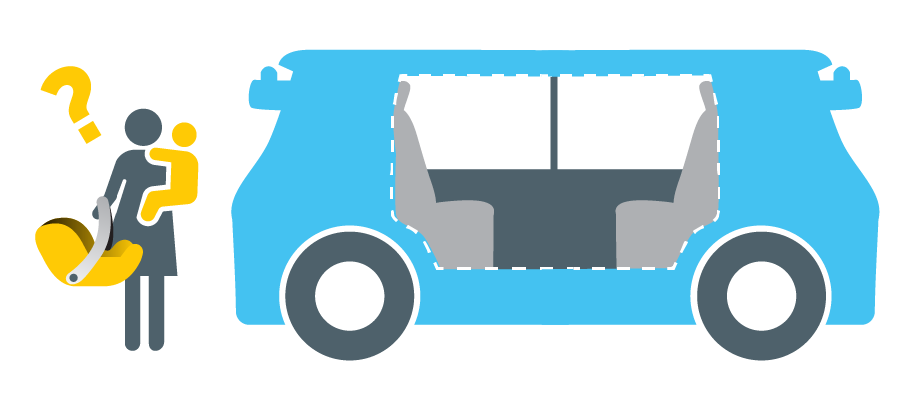Considerations for Driver Seating Positions
For example, in current vehicles, driver seating positions are not required to meet regulatory requirements related to the safe seating of children (i.e., those covering air bag protection, seat belts, and universal anchorage systems) because a child could never occupy such a seat. However, in AVs (including dual-mode vehicles in which the steering column can be deactivated/stowed), children could potentially occupy any seating position. Therefore, any exemptions for drivers’ seats would need to be lifted and/or additional requirements fulfilled.
NHTSA has declined at this time to rule on its proposal for suppression of vehicle motion when a child is detected in a driver’s seat (as in dual-mode AVs), citing the need for more research. While this research is welcomed, vehicles that pose such risks to children should be prevented from being introduced to the public until the research is complete and any findings are implemented.
Considerations for Non-Driver Positions
For non-driver positions, current regulations standardize certain aspects of child restraint installation, and in some cases, the spatial compatibility between these systems and the vehicle interior. Typically, the location and arrangement of anchorages are defined with respect to fixed seating positions and reference points. This ensures any given child restraint system can be used in the widest possible range of vehicles, and that child restraint can be tested in a laboratory in the same way they are used in the real world. However, AV publicity often touts the potential for alternative and/or flexible seating layouts. Being freed of the constraints of a driver sitting in a certain seat with certain controls, interiors have been creatively reimagined. A volunteer study by Jorlöv et al. (2017) found a preference for a “living room” layout with the front seats rotated between 90° and 180°. In the U.S., NHTSA has said that it is currently studying the ramifications of non-traditional configurations like campfire and lay-down seating (Federal Register, Vol. 85, No. 61/March 30, 2020, p. 17627).
Considerations for Child Restraint Configurations
Today, child restraints are certified to protect children when installed on a forward-facing vehicle seat only. A rear-facing vehicle seat, typical of a living room layout, would change the orientation of the child restraint from that it was tested and certified for. Naturally, it would be particularly unsafe for a young child to travel in a rear-facing child restraint that is actually forward-facing or side-facing (i.e., because the vehicle seat does not face forward). Similarly, a forward-facing vehicle seat capable of rotation may put the child restraint out of position with respect to vehicle anchorages or interior surfaces that are essential to its proper installation. Therefore, any shift toward non-traditional seating configurations would need to be reflected not only in vehicle regulations but coordinated with child restraint system regulations, as well. Any move toward vehicle interior variability and/or flexibility would require careful planning for children in order to ensure that compatible child restraint options are ample and readily available. In addition, it should consider the implications of different kinds of crashes. For example, if a child is able to be seated towards the front of the vehicle, they are more vulnerable because front collisions are more dangerous.
One solution might be to establish rules that require AV manufacturers to provide and identify ‘child-friendly seating positions within AVs, although that begs many questions, including whether such seating designations would be followed in practice, impose unreasonable limitations on families and/or create enforcement challenges. Alternatively, new child restraints and attachment mechanisms compatible with and/or adaptable to any potential layout may need to be developed. If such hyper-adaptable child restraints are not feasible, vehicle- or seating-specific models may be necessary. Another development associated with AVs is the potential for vehicles that can change their direction of travel without turning around (dual-directional versus the current norm, mono-directional). In an AV that alters direction, a child restraint installed for a child’s appropriate stage (facing the rear or forward) could suddenly face the opposite direction. Therefore, using any of today’s child restraints in a dual-directional vehicle introduces the potential that they’ll be used in an orientation for which they are not designed or tested. Approaches to child safety in dual-directional vehicles need to be invented, as they do not currently exist.
These potential outcomes will call for novel approaches to child passenger safety. Solutions would need to meet the lifestyle needs of families while offering at least the equivalent level of protection that children receive today. Importantly, any new systems that are developed for protecting child passengers in the automated vehicle age will need to be solidly in place before dismantling any regulations that facilitate current child passenger safety approaches. Establishing such new systems will be a major undertaking that will require a considerable amount of lead-time, resources, and, ideally, an internationally coordinated effort.






